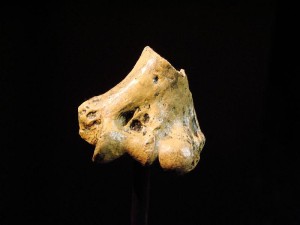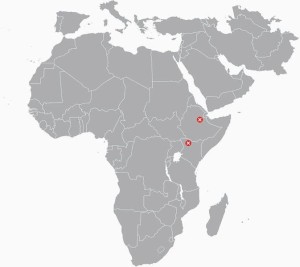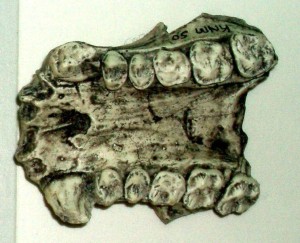Part III: Pliocene Epoch
10. Australopithecus anamensis
Australopithecus anamensis (4.2 mya)
(“southern ape” / from the “lake” in the Turkana language)

SITES
Allia Bay and Kanapoi, Kenya
PEOPLE
Meave Leakey and Alan Walker
INTRODUCTION
Australopithecus anamensis is the earliest known australopith. We do not know nearly as much about the species as about other australopiths due to a paucity of fossil material.
PHYLOGENY
Au. anamensis may be descended from the ardipith lineage or a heretofore undiscovered group. Lucy’s species, Au. afarensis, may be descended from Au. anamensis.
DISCOVERY AND GEOGRAPHIC RANGE
Multiple paleoanthropologists (most notably Meave Leakey and Alan Walker) are credited with the discovery of Au. anamensis material. The species name refers to the Lake Turkana area of Kenya where the fossil sites of Kanapoi and Allia Bay are located (see Figure 10.2). There are also newer fossils from the Middle Awash area of the Afar Depression of Ethiopia (see Figure 10.2). The Ethiopian material is close in time and geographic space to an Ardipithecus ramidus site, lending some support to the possibility of their phylogenetic relatedness. There is some controversy over the lumping together of material from different levels and locations in Kenya that could have confounded the description of the species’ characteristics.

PHYSICAL CHARACTERISTICS
The species is thought to have been highly sexually dimorphic in body and canine size.
Much of the morphology is ape-like, and hence primitive. The jaws and teeth are the most primitive of any australopith, which is not surprising since it is the oldest. Unlike the parabolic tooth arrangement in the jaws of later hominins, Au. anamensis had an apelike, U-shaped dental arcade wherein the cheek teeth are nearly parallel (see Figure 10.3). Their jaws were also prognathic and their canines were larger than descendent species. However, the molars were expanded with thick enamel and low cusps like later hominins. In addition, aspects of the elbow, knee, and tibia were more derived, indicating its bipedal mode of locomotion.

Review of Primitive Characteristics
- High degree of sexual dimorphism.
- Prognathic jaws with ape-like parallel cheek teeth.
- Larger canines than subsequent species.
Review of Derived Characteristics
- Expanded molars, low cusp relief, and thick enamel.
- Bipedal adaptations of elbow, knee, and tibia.
ENVIRONMENT AND WAY OF LIFE
Fossils have been found in a variety of paleoenvironmental settings, such as lakeside, woodland, and more open areas. The species likely slept in trees and foraged both in trees and on the ground, as they moved bipedally around their home range in search of resources and mates. The high degree of sexual dimorphism and the presence of the honing complex suggest a polygynous or polygynandrous mating system. The former may have involved a one-male/multi-female social organization and the latter, a multi-male/female pattern. A one-male system may have looked more like that of gorillas, where both males and females tend to leave their natal group. However, if we use chimps and bonobos as a model of our ancestral social organization, it was more likely a multi-male/female social organization, with males staying in their natal group (i.e. male-philopatric) and females leaving at sexual maturity to join another. While it is easy to use our more closely related relatives to reconstruct our past behavior, we must remember that social organization is a function of both phylogeny and ecology. Taking both into consideration, in combination with their anatomy, it is more likely that Au. anamensis were more chimp-like. Their teeth do not have the higher cusps of the more folivorous gorilla, so their diet was likely more chimp-like and hence a combination of fruit, tender greens, and opportunistic animal matter. As mentioned in Chapter 5, that type of diet is harder to come by and females may have needed males to defend a territory for their nutritional needs and those of their offspring. Interestingly, isotopic analyses of Paranthropus robustus (robust australopith from South Africa) fossil material show that while males were from the area where the fossils were found, females were not. Thus we now have a fourth line of evidence favoring male philopatry.

